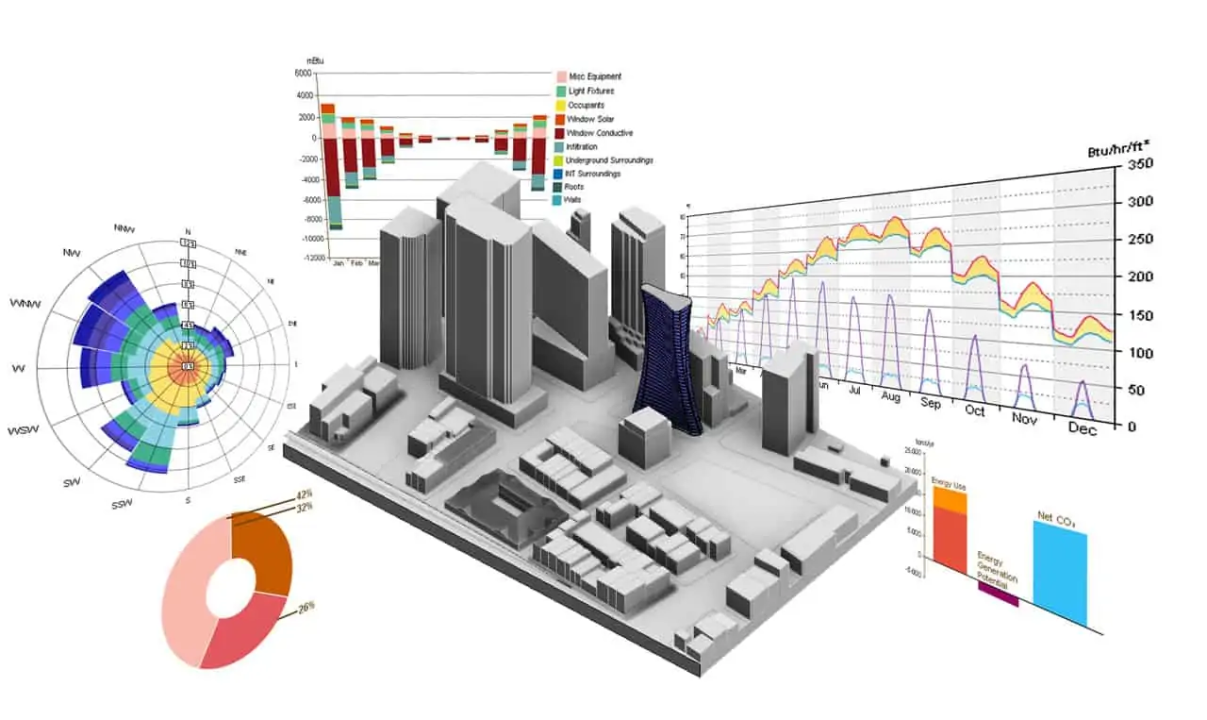
In civil engineering, where every detail is crucial, cost estimation accuracy can truly make or break the project. It is not always about keeping within budget but also about foreseeing potential financial pitfalls before they become unmanageable. Traditionally, cost estimations have been filled with challenges, ranging from data inaccuracies to unforeseen changes in the project scopes, leading to budget overruns and project delays. Civil engineers can leverage more dynamic and accurate resource allocation methods with BIM cost estimating software integration. Read this blog to know how!
Importance of Cost Estimation in Civil Engineering
The importance of cost estimation in civil engineering cannot be overstated. It impacts every project stage from conception through completion. However, utilising advanced tools like BIM-based cost estimating, construction estimating tools or building estimating software can enhance the chances of the overall project accuracy. Let’s understand the importance of cost estimation and why it is pivotal for sustainable and successful civil engineering projects:
1. Ensuring Project Feasibility and Sustainability
One of the primary roles of cost estimation in civil engineering is ascertaining the project's financial feasibility. By providing a clear picture of the anticipated costs, engineers and project managers can determine whether a project is economically sensible and sustainable over the long term. Effective cost management, driven by accurate estimations, helps secure funding and gain stakeholder approval, laying a strong foundation for project initiation.
2. Budget Management and Resource Allocation
The right cost estimation enables efficient budget management and resource allocation. Using construction estimating tools, engineers can forecast financial needs, allocate resources more effectively, and avoid the pitfalls of under or over-budgeting. These tools assist in tracking the financial health of a project throughout its lifecycle, ensuring that the project remains financially viable from start to finish.
3. Risk Mitigation
Civil engineering projects come with their share of financial risks, including cost overruns and misallocated budgets. Implementing precise cost estimation practices, facilitated by advanced building estimating software, significantly mitigates these risks. By finding the potential financial pitfalls before they occur, teams can set strategies to address them proactively, thus maintaining control over project costs and timelines
4. Integration of Advanced Technologies
The integration of advanced construction cost estimator software into civil engineering projects marks a significant advancement in cost estimation practices. BIM helps in reducing the chances of error by providing a three-dimensional, real-time, and dynamic modelling process. This technology allows for more detailed and comprehensive planning, which improves the precision of cost estimates and the overall project management.
Also Check out: Risk Mitigation in Civil Construction Projects Using BIM
What is Building Information Modeling (BIM)?
Building Information Modeling (BIM) is a digital technology that represents the physical and functional characteristics of a building in a virtual model. Imagine it like playing a highly advanced version of a building game, where you not only create structures but also simulate real-world elements and operations that will affect those structures over time. It is extensively used in the construction industry to help architects, engineers, and other team members for better planning to prevent potential design and construction issues.
Traditional methods of estimating costs often rely on paper work like static spreadsheets and manual calculations, which can be time-consuming and prone to errors. With BIM, the process becomes dynamic and integrated. Building estimating software that supports BIM can automatically pull detailed information from the model to provide more accurate and rapid cost estimations.
BIM cost estimating software leverages the 3D model to track and manage costs throughout the project's lifecycle. This ongoing cost management helps teams make informed decisions quickly, adjust plans as necessary, and manage resources more efficiently, leading to cost savings and excellent project outcomes.
Impact of BIM on Construction Cost Estimation
Using BIM in the construction industry has transformed how professionals work. Here, we will explore the crucial impact of BIM on cost estimation, showing how it has become an irreplaceable tool for construction professionals:
1. Accuracy in Cost Estimates
BIM for cost estimation integrates all necessary data into a single digital model, providing a project’s comprehensive and detailed view. This integration allows cost estimating software to extract data directly from the BIM model, ensuring that estimates are based on the latest project information. The use of construction cost estimating software that is BIM compatible helps in minimising inaccuracies and assumptions, leading to more precise estimates.
2. Real-Time Cost Details
BIM cost estimating tools allow for real-time cost updates as the project design evolves. Changes made in the BIM model are automatically reflected in the cost estimates, thanks to BIM cost estimating software. This defined approach to cost management is a significant improvement over traditional methods, where updates to estimates often lag behind changes in design, sometimes leading to budget overruns and schedule delays.
3. Seamless Coordination
It enables better collaboration among all stakeholders involved in a construction project. With building estimating software that supports BIM, cost estimators, architects, engineers, and contractors can all access the same updated model. This accessibility ensures that everyone is on the same page and can make informed decisions when required. Enhanced collaboration results in a more efficient process where cost-related decisions are made with a clear understanding of their impact on the overall project.
Best Practices for Cost Estimation Using BIM
By integrating BIM with construction cost estimating software, professionals can create more reliable, precise cost estimates. Here are some best practices for making the most out of cost estimation using BIM models.
1. Integrate the Right Software
Choosing the right building estimating software that supports BIM integration is essential. Top construction estimating software typically includes features that allow for seamless integration with BIM models, extracting necessary data to create detailed cost estimates. Ensure that the software you choose is compatible with the BIM technology in use and is capable of handling the data complexity BIM models provide.
2. Train your Team
Ensure that your team is well-trained in both BIM and the specific cost estimating software you are using. Understanding how to navigate and manipulate BIM models and extract the needed information for cost estimation is critical. Regular training sessions can help keep your team updated on the latest software updates and techniques.
3. Communicate with the Team Effectively
Since BIM models are used across various stages of the construction process by different teams, ensuring that everyone understands how to use the information within these models for cost estimation is essential. Use construction estimating tools that promote real-time data sharing and updates.
4. Update BIM Models Regularly
Ensure that the models are detailed and updated regularly to reflect any project changes or adjustments. This practice helps maintain correctness in the BIM cost estimating process, as the data drawn from these models directly influences the cost projections.
Also Check out: Top 10 Architecture Design Software
BIM Tools and Software for Cost Estimation and Analysis
There are numerous tools available, but finding the reliable ones can be a daunting job. Here, we have listed top BIM tools and software for that helps in cost estimation and analysis:
1. Autodesk Revit
Autodesk Revit is one of the widely recognised and used construction cost estimating software available today. It is particularly useful for architects, engineers, and construction professionals due to its ability to create detailed 3D models that integrate design and documentation with cost estimation processes. Revit's parametric modelling capability means that any change to the design is automatically updated across all related documentation, including cost estimates. This integration ensures that shareholders can see how changes in materials, design, or timelines affect project costs, making Revit an essential tool for BIM based cost estimating.
2. Autodesk Civil 3D
Civil 3D from Autodesk enhances precision in civil infrastructure projects, including roads, land development, and environmental projects. It supports BIM for cost estimation by providing tools specifically tailored for civil engineering design and documentation. Civil 3D helps professionals better predict project outcomes, improve drafting and detailing efficiency, and quickly adjust designs in response to project demands or environmental factors.
3. Graphisoft ArchiCAD
Another building estimating software that offers architects and designers advanced tools for designing and detailing every aspect of architectural projects in a fully integrated BIM environment. One of its standout features for cost estimation is its built-in quantity and cost estimation tools, which automatically calculate the materials and their costs as the design progresses. This not only speeds up the cost estimation using BIM process but also ensures accuracy and compliance with geographical design standards, making ArchiCAD a preferred choice for projects around the globe.
4. Rhino
Rhino is popular for its versatility in handling complex shapes and non-uniform designs. While not a typical BIM tool, Rhino works seamlessly with plugins like Grasshopper to support BIM cost estimating. Grasshopper is a visual programming language integrated within Rhino that can automate processes and generate detailed models from which precise cost data can be derived. When used in conjunction with other construction cost estimating software, Rhino extends the design capabilities and integrates them with detailed cost analysis.
Future Trends & Opportunities of BIM for Cost Estimation & Budgeting
BIM is continually evolving, shaping the future of the construction industry, especially in cost estimation and budgeting. Here are some key trends and opportunities that are enhancing the usage of BIM:
1. Integration of AI and Machine Learning (ML)
The integration of Artificial Intelligence (AI) and Machine Learning (ML) with BIM cost estimating software is a promising trend. AI can analyse historical data and learn from past project outcomes, improving the accuracy of cost estimates and budget forecasts. This technology can predict potential cost overruns and suggest budget adjustments based on real-time data inputs, significantly enhancing predictive capabilities in construction cost estimator software.
2. Detailed Modular and Prefabrication Modelling
As modular and prefabrication construction methods gain popularity, BIM tools are expected to offer more detailed functionalities that can model these processes accurately. This will allow cost estimators to break down the costs associated with prefabricated components more effectively, using construction cost estimating software to optimise budgeting and ensure cost savings.
3. Increased Focus on Sustainability and Cost Efficiency
Sustainability is becoming a critical consideration in construction. Future enhancements in BIM based cost estimating are likely to include better tools for analysing the environmental impact of materials and construction methods. This will not only help projects meet sustainability standards but also improve cost efficiency by integrating life cycle cost analysis directly into the BIM models. This process ensures that long-term costs, including maintenance and energy consumption, are considered into initial budgeting decisions.
Training and Certification Programs for BIM for Civil Engineers
Civil engineering is a dynamic field that constantly evolves with technology and best practices. For aspiring civil engineers or professionals looking to enhance their skills or stay updated with the latest industry trends, taking specialised courses can be beneficial. Here are the top courses that are highly recommended for civil engineers:
1. BIM Professional Course for Civil Engineers by Novatr
Duration: Eight months
The BIM Professional Course for Civil Engineers offered by Novatr provides a comprehensive learning experience through live sessions, real-world projects, and expert mentorship. The curriculum covers a broad range of topics, from the fundamentals of BIM to specialised applications like 4D and 5D modelling, cost estimation, and infrastructure BIM which are crucial for today’s AEC industry. The course also includes career support services such as job placement assistance, mock interviews, and portfolio reviews, preparing graduates to advance in the rapidly evolving construction sector.
Also Check out: BIM and Clash Detection: Ensuring Design Integrity
2. BIM and Structural Design Analysis by IFS Academy
Duration: Four months
It is a specialised online training course for civil engineers and construction professionals. This comprehensive program equips participants with essential skills in BIM and structural design analysis, utilising industry-standard software and tools. The course will offer theoretical knowledge and practical application, offering hands-on training through live projects that mirror real-world challenges.
3. MBA in Digital Transformation and BIM management by NICMAR
Duration: Two years
The course provides a comprehensive understanding of the managerial aspects of construction projects and the technical elements of BIM. It aims to equip students with the knowledge to manage BIM projects effectively, integrate new technologies into their workflows, and improve project outcomes. Graduates of this program are well-prepared to take on leadership roles and facilitate digital transformation in their organisations.
Conclusion
BIM is transforming the cost estimation process in civil engineering by making it more efficient and accurate and reducing errors compared to traditional procedures. By integrating BIM with top construction estimating software, civil engineers can ensure that the projects are not only financially viable but also optimised for cost savings.
Besides this, aspiring civil engineers must stay updated with the industry trends, and for this, you can enrol in the BIM Professional Course for Civil Engineers offered by Novatr. This course will help you learn vital BIM cost-estimating software, encompassing everything from the first stage of planning to cost estimation. So, whether you are a professional who wants to enhance your skills or a student seeking a course, Novatr is the right place for you to learn a strategic understanding of BIM in civil engineering.
Do check out our Resource Page for industry trends!
Was this content helpful to you










